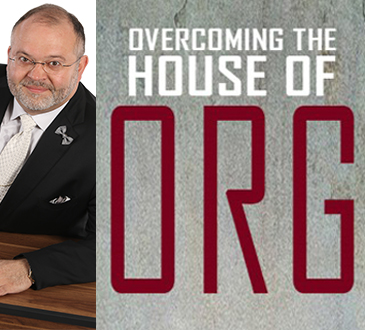
Major Gift – How Do You Quantify One?
September 7, 2019
Jimmy LaRose Charity Champion – Video
September 7, 2019Nonprofits Fail – Here’s Seven Reasons Why – Tracy Ebarb

Why Do Nonprofits Fail? Does it seem a bit crowded in here?
A few years ago, during his presidential campaign, Dr. Ben Carson made the statement that 90% of nonprofits fail within a few years. While Dr. Carson’s statement was largely hyperbole, it did call to attention the alarming rate of both nonprofit failure and ineffectiveness. The real data from National Center on Charitable Statistics reveals that approximately 30% of nonprofits fail to exist after 10 years, and according to Forbes, over half of all nonprofits that are chartered are destined to fail or stall within a few years due to leadership issues and the lack of a strategic plan, among other things.
There are currently over 1.5 million tax exempt non profits in the US.
In Texas alone, there are about 106,000 non profits, about 1 for every 4000 people.
In recent years the “overhead problem” has begun to be addressed. The irony is that we did this to ourselves in the first place. Instead of clearly communicating WHY an organization needed money to be invested in overhead, virtually all nonprofits educated donors that money spent on overhead was bad! We created that story by showcasing that operating on a shoe string budget was a badge of honor. However, when we do that we are actually perpetuating and encouraging a ‘race to the bottom’ mentality where success is measured by how little we spend, not by the impact we have.
Time and time again, we see research that shows the organizations that invest in technology, talent, and professional development end up making greater gains. The old adage from the for-profit world, “You have to spend money to make money”, is widely accepted— but not so, in the nonprofit world. In The Rise and Fail of Charities in the 21st Century, Elsey points out that “Nonprofits should not be having a conversation with donors about how little they are spending. They should instead be speaking to them about how much impact they are having relative to their budget….It should not be a badge of honor to be proud of operating on a shoestring budget.”
Remember, when you stick with the “Tin Cup” mentality and fear asking for an investment —you’re missing an excellent opportunity to articulate to donors the reason you need them and their funding and how they are helping to increase impact.
Also, don’t forget – 501c3 is a tax status, not a business model.
7 REASONS WHY NONPROFITS FAIL
- Empty Optimism – or Pie in the Sky Dreams (without the proper ingredients to bake a pie)
I’ve seen some of the best, most needed (in my view), and earnest efforts falter and fail because the leaders simply did not accurately calculate the amount of support that would be available and the alliances and partnerships that they would need to support their humble beginnings. In other words – they lacked a sound business plan upon which to build a platform for success. The old saying ‘to fail to plan is to plan to fail’ is so very, very true.
- Values Vacuum – or Poor Organizational Development
Healthy organizations establish core values that guide the way leaders and staff do business, and how they deal with each other and with outside people and groups at every point of contact. It is far too common for autocratic and self-focused founders to establish one core value: “do as I say.” These nonprofit heads find it very difficult to transfer authority or to share the limelight and leadership with an empowered team. There is little internal trust, and insufficient values to guard against abuses of power, privilege, and people. It is also an environment in which many unethical and even illegal practices can flourish, and often do. These organizations frequently fail in the first generation, and almost never thrive when the leader with all of the chips finally cashes them in.
- Competitive Blinders – or ‘we’re unique, there’s no one like us in the market’
Nonprofit leaders and ministry executives are frequently insular and blind to the external changes and “market” forces that will be their undoing. Often it’s because they are so focused on the needs and crises around them. Or they cannot imagine anyone or anything that would deter them from their righteous ends. And charities are often unfamiliar with, or even repelled by, the notion of “competitors,” so they don’t recognize true rivals or adjust to compete. There is no ability to adjust programs to match changing situations, culture, or competition and to compete for donations, volunteers, media coverage, or program space. This blindness also manifests itself in the lack of research done to determine if there are other Organizations doing the same thing, with basically the same goals. This along with a self-righteous notion that “we” can do it better, or the right way, when cooperation, even merging with another Org would be so much more efficient.
- Iced Innovation – or the notion that ‘our website is good enough for now’…
Nonprofits must Embrace Technology
Mobile access, mobile devices and the experience on the internet has changed user expectations and has also provided nonprofits with a more level playing field.
Take a look at the businesses that have grown quickly over the past years, innovative companies which are “disruptive” or at least are very different from doing “business as usual.” Apple, Amazon, Netflix, Zappos. Or nonprofit organizations which leverage technology to deliver on mission, like DoSomething.org and donorschoose.org.
Today’s donors are also today’s online shoppers. So your “competition” isn’t the other charity with a similar mission–it’s Zappos. Today (and tomorrow’s) donors are accustomed to finding and buying what they want, when they want it.
Ask yourself this question: Is your organization set up to allow donors to find and give you what they want to give, when they want to give it? Now pick up your smartphone and see how easily and quickly (or not) you can find your site and make a donation– because they will not go to a desktop to make a donation or share their affinity for your cause, when the ability to do so is right at their fingertips. It’s what they’re used to.
The good news is that this technology also makes the playing field for causes, more level. Just a handful of years ago, DRTV might have been the most effective way to reach a mass audience—but, due to expense, was only available to organizations with the largest budgets. Today’s technology allows any sized organization the ability to communicate, educate, and engage on a greater scale than ever before—at little cost.
The emergence of the Internet and subsequent online innovations that have changed the world in many ways has made strikingly obvious a business truth that is actually timeless. If you do not innovate, you will disappear. If there is no adjustment of creative content, communications, or methods for new times and trends you will miss opportunities, and be judged as antiquated (and perhaps irrelevant). Creative presentation and original thinking buy you another look, enable you to capture attention in a crowded field, and present new ways for people to engage with your mission.
- Mission Creep or ‘yeah, we should do that too!’
When a corporation goes beyond its initial product line and area of service, it’s called brand extension. In nonprofits, we call it mission creep, and because charities are in the business of changing the world, their leaders often cannot seem to stop themselves from seeing every need as a call. The result is too many directions, no mission clarity, diffused expertise, and donor confusion.
- Misplacing Priority #1 – or forgetting who the ‘real boss’ is
At the end of the day, for nonprofit organizations – Money is more important than Mission. Nonprofits exist to serve and to meet needs on a global scale, and we care deeply for the causes we embrace, often to the detriment of our funders. A successful nonprofit knows that their #1 Customer is their donors, period. Without the donors, there would be no impact, no people served, no mouths fed, no backs clothed. Those we serve are important, but if we really want to have an impact, we must take care of our donors first, we must make sure that our programs are designed to give our donors an opportunity to fulfill the goals they have for their philanthropy, and then constantly communicate to them the impact their dollars are having. And when it comes to taking care of donors, relationships, personal relationships are KING! No fancy CRM or automated gift response mechanism will ever trump a personal relationship.
- The Data Conundrum – or the fear of information
Although many organizations have begun measuring every possible statistic related to fundraising efforts, few have enough data to guide planning, analyze management systems, or redirect underperforming programs or communications. This may be because of the pressure to reduce overhead, or because the entrepreneurial spirit of charity leaders causes them to fly by the seat of their pants, to trust their own (often flawed) instincts. Also factor in the age-old truism – “there’s paralysis in analysis” – there’s a real and present danger for Organizations who dive too deeply into the studying the data on their donors at the expense of personal relationships.
Common mistakes of failing nonprofits fit into the categories below.
- Not Having a Qualified Leader.
A leader of a nonprofit needs the following traits: A head for business, Desire to do good, Sincerity, Confidence, Goal Setting, Organization Skills - No Website Or Poorly Designed Website.
Make a user-friendly website, avoid bulky language, make sure the contact information is accessible & accurate. Have strong compelling content. A rule of thumb is make sure nothing is further than “two clicks deep”. Display your mission in a clear area. Have a clear button to donate on every page. - Poor Planning and Record Keeping
No plan of action. A nonprofit is much like a business. There has to be a clear plan to get funding to stay afloat. - Poor Accounting and Money Management
Building a solid capital structure is a key, Keep Strict Money Records, File all Documents & Forms Correctly and on time, Set Aside Seed Money, Spend wisely Evaluate Wants Versus Needs - Marketing Only to Large Donors and Not Thinking Smaller Donors are Just As Important
Small donors are just as important as large donors. Don’t expect donors to maintain or increase the size of their contribution each time they give. Thank every donor in every circumstance they donate no matter how much they give - Nonprofit Doesn’t Mean Tax Exempt.
Know your tax laws and file your taxes.
Ultimately, the real reason nonprofits fail is because they shouldn’t have existed in the first place.
7 Reasons Why Nonprofits Fail was written by Tracy Ebarb, Veteran Fundraiser and the National Association of Nonprofit Organizations & Executives’ International Director. Tracy’s journey in the nonprofit world began in the early 80’s through his service on Church Staff as Youth Minister, Associate Pastor, Church Administrator, Director of Development and Stewardship and Senior Pastor. Tracy joined the renowned consulting firm of Cargill & Associates in 1998, designing and conducting over 60 Capital Stewardship Campaigns raising over $50 million dollars. As an independent Consultant, Tracy has traveled extensively overseas raising funds and working to develop humanitarian projects in the African nations of Sierra Leone, Malawi and Zambia, and the Central American nations of Nicaragua, Haiti and Honduras. As well as consulting and developing Capital Fundraising Campaigns in over 75 churches and nonprofits across the US. Until recently, Tracy has guided the International Bowling Museum and Hall of Fame as the Director of Business Development. He has recently accepted the position of Senior Counselor at Development Systems International.
You can also read Tracy Ebarb’s Donor Recognition – And A Child Shall Lead Them published here at NANOE News.
The post Nonprofits Fail – Here’s Seven Reasons Why – Tracy Ebarb appeared first on NANOE | Charity’s Official Website.
